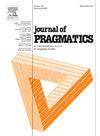回应呐喊和语法
IF 1.7
1区 文学
0 LANGUAGE & LINGUISTICS
引用次数: 0
摘要
反应哭声被描述为人类交流中的仪式化行为,是对当地事件的本能反应(Goffman, 1978)。尽管有证据表明它们是在特定的互动时刻实现的,例如对医生的启发做出的痛苦表情(Heath 1989)或新闻或故事后的惊喜标记(Wilkinson &;Kitzinger 2006),研究还没有探索它们如何与语法组织起来,并融入到回合设计中。本研究解决了这一遗漏问题,并针对句法结构与应答呼叫之间的关系进行了研究。基于来自各种情境的数据,如家庭聚餐、运动训练和表演排练,我们展示了反应哭声是如何以反射性的方式产生的,这些方式精心设计了共同发生的立场结构和具体表现,以形成一个句法整体。我们认为句法理论应该在其范围内包括这样的结构,以免它们不能解释语法在响应交互需求时出现的方式。本文章由计算机程序翻译,如有差异,请以英文原文为准。
Response cries and syntax
Response cries have been described as ritualized acts in human communication that come off as visceral reactions to local events (Goffman, 1978). Despite evidence that they are implemented at specific interactional moments, such as pain expressions in response to doctor's elicitation (Heath 1989) or surprise tokens after news or stories (Wilkinson & Kitzinger 2006), research has yet to explore how they are organized in relation to syntax and incorporated into turn design. This study addresses this omission and targets the relationship between syntactic constructions and response cries. Based on data from a variety of contexts, such as family meals, sports training, and performance rehearsals, we demonstrate how response cries are produced in ways that reflexively elaborate co-occurring stance-taking constructions and embodied displays to make a syntactic whole. We argue that syntactic theories should include such structures in their scope, lest they fail to account for the way syntax emerges in response to interactional requirements.
求助全文
通过发布文献求助,成功后即可免费获取论文全文。
去求助
来源期刊

Journal of Pragmatics
Multiple-
CiteScore
3.90
自引率
18.80%
发文量
219
期刊介绍:
Since 1977, the Journal of Pragmatics has provided a forum for bringing together a wide range of research in pragmatics, including cognitive pragmatics, corpus pragmatics, experimental pragmatics, historical pragmatics, interpersonal pragmatics, multimodal pragmatics, sociopragmatics, theoretical pragmatics and related fields. Our aim is to publish innovative pragmatic scholarship from all perspectives, which contributes to theories of how speakers produce and interpret language in different contexts drawing on attested data from a wide range of languages/cultures in different parts of the world. The Journal of Pragmatics also encourages work that uses attested language data to explore the relationship between pragmatics and neighbouring research areas such as semantics, discourse analysis, conversation analysis and ethnomethodology, interactional linguistics, sociolinguistics, linguistic anthropology, media studies, psychology, sociology, and the philosophy of language. Alongside full-length articles, discussion notes and book reviews, the journal welcomes proposals for high quality special issues in all areas of pragmatics which make a significant contribution to a topical or developing area at the cutting-edge of research.
 求助内容:
求助内容: 应助结果提醒方式:
应助结果提醒方式:


